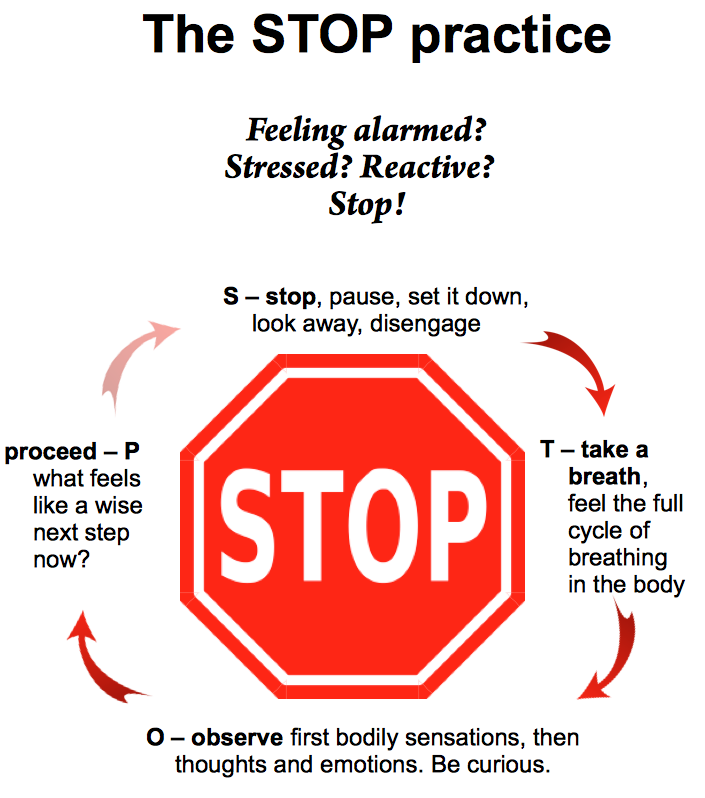
Photo by Ahmad Gunaivi
We all know those moments. We’re already wound up. Rushed. So much going on. And we’re also tired from an interrupted night of sleep. Or worried about a health challenge. Or a family member who’s back in that familiar crisis zone. We carry so much and so much is asked of us.
And then one more thing – one more challenge – one more interruption – one more fire to put out. It’s just too much. And in those moments we can so easily make a difficult situation worse with a reactive response.
Mindfulness, of course, can really help here. Because we need a way to hit the pause button. To catch our breath. To take a fresh look. But when we’re half-there, distracted, rushed, it’s really hard to access our inner wisdom and experience. The neuroscience even tells us that the more thoughtful parts of our frontal cortex are pretty much turned off when we’re stressed and distracted.
STOP is a practice that’s helped me hit the pause button many times.

Here’s an example:
It was early in the creation of Mindfulness Northwest. We were much smaller then and I was holding a lot of balls in the air all the time, and dropping quite a few! We were about to offer our first weekend retreat at Samish Island Retreat Center and I was at my desk working away. I felt even more behind than I usually do now. It felt like I could never quite keep up with the questions and inquiries and decisions to be made as Mindfulness Northwest kept growing.
One of the many messages in my inbox was from a woman who was signed up to join our weekend retreat. Once I opened her email, I could quickly tell that it was an “escalation” message. Clearly, I’d missed her previous message. I read on and found her quite reasonable question about what to bring to the retreat. Busy as I was, I whipped off a reply and kept reading through my inbox.
What I know now is that I was also feeling some shame and distress as I fielded the woman’s message and many of the others. It doesn’t feel good to miss a message. To be behind. To not be there for people fully. But in that moment, I shoved such feelings under the surface and kept plowing along.
Several messages later I glanced at the inbox to see another message from the same woman! “What?” my inner dialog went, “I already replied to you!” But I dutifully opened this second message. I remember it word for word:
Dear Tim,
Thank you for your reply. It all makes sense and I’m looking forward to the retreat.
And I hope this teaches you.
Sincerely…
Instantly I felt my body tense and my emotions surge. My mind was off to the races: I hope this teaches you? What do you think it’s teaching me?! Hey, I’m doing my best here. I wasn’t even paying myself a salary at the time and there I was working my butt off. I’m trying here for goodness sakes! Who the *&^*@ do you think you are?
I could feel my fingers poised to write an angry reply right back to this presumptuous person, in spite of the fact that I was offering community programs in mindfulness and stress reduction as my new career.
Just then, thankfully, I remembered STOP.

Photo by Aleksandr Kadykov
S for STOP: I took my hands off the keyboard and put them in my lap. The world was safe for the moment from an angry email from me.
T for Take a Breath: I paused to feel my breath: it was high and shallow in my chest. I gave myself a few breaths to let the energy drop down toward my belly again and breathe a bit better. I was starting to calm down a little.
O for Observe: Here is where the mindfulness rubber really hits the road. I felt my tight face, my clenched jaw, and my hunched shoulders. I observed how defensive, upset and angry I was. Pausing a little longer I could see that under the anger was that feeling of shame and distress. And also fear: was this mindfulness thing going to all come crashing down in the end?
As I breathed and tuned into my body and emotions, I could feel some of the knots softening.
And my mind was able to access curiosity again. I tentatively tried some reframing. “Tim, you don’t really know what she meant by that, maybe it’s not what you think.” I was still upset for sure, but the feeling was shifting. And shifting pretty quickly.
P for Proceed: I wasn’t quite sure how to proceed. I did have the sense to NOT start planning an email back to this person. But should I keep working and handle other emails or tasks? Should I take a break? Maybe a walk around the block would be a good idea? As I was pondering this I glanced at the screen and to my great surprise, a third email appeared from this same person!

Photo by Nick Fewing
Okay…I shakily said to myself, let’s just see what she says now. And I read:
Dear Tim,
I just wanted to write again to share that I’m so looking forward to the retreat.
And, funny typo in my last message, I meant to write: “I hope this reaches you.”
See you soon…
The whole triggering incident had been….a typo.
But it also revealed a lot to me about where I was at in those moments. It helped me recalibrate a bit. Plus it does make a helpful teaching story! So I’m grateful for this funny mix up. All the more so because I actually managed to remember to use a tool of mindfulness instead of making things worse.
Janice Marturano in her helpful book, Finding the Space to Lead: A Guide to Mindful Leadership, points out that a core problem here is:
We have a national – if not worldwide – epidemic of continuous partial attention. We go on autopilot for much, or all, of our lives. We begin to believe that this is just how it has to be in the fast-paced, distraction-filled world we work and live in. If we don’t live on this incessant treadmill, we’ll fall behind, or fail.
So often we’re barely here and this makes us so vulnerable to the one-more-things of this busy world.
Taking purposeful pauses really helps. When we tune in, even for a few moments, to what’s really true now – and how we are in the middle of it all – a moment of wholeness arises. We come back to ourselves. Our inner resources have room to come back online. Somehow our wiser selves are never too far away even if they don’t put in an appearance too often on those crazy-busy days.
Taking a purposeful pause regularly can be a great preventative, too. And I’m not talking about stopping to look at my phone or adding to my to-do list. I mean getting up from the desk for a stretch. That walk around the block (does the idea “I don’t have time for that” really hold up?). Making a cup of tea. Gazing out of the window a moment to just…be. Shifting the frame. There are so many ways to look at this; but the key thing is taking the time to do something. Almost anything other than the autopilot’s next spin of the treadmill.
A practice like STOP doesn’t come to mind every time I get upset. And nobody’s perfect. But as I use these practices they are available to me more often. Learning and practicing these tools regularly is like planting seeds. It won’t always “work” – we aren’t machines – but the seeds will germinate more and more often. The ability to shift, to see, to feel more clearly will be there more often. It all takes a lot of patience. It took all the years of your life to develop the patterns you have now. It’ll take some time to cultivate new patterns. But it does happen.
Wishing you the best in navigating with wisdom and kindness,
Tim
P.S. Find this and other brief practices on our website.
Tim Burnett works at Mindfulness Northwest as our Executive Director.
This article was part of our Practice Letter newsletter. If you’d like to receive this monthly publication in your Inbox, please sign up here.

